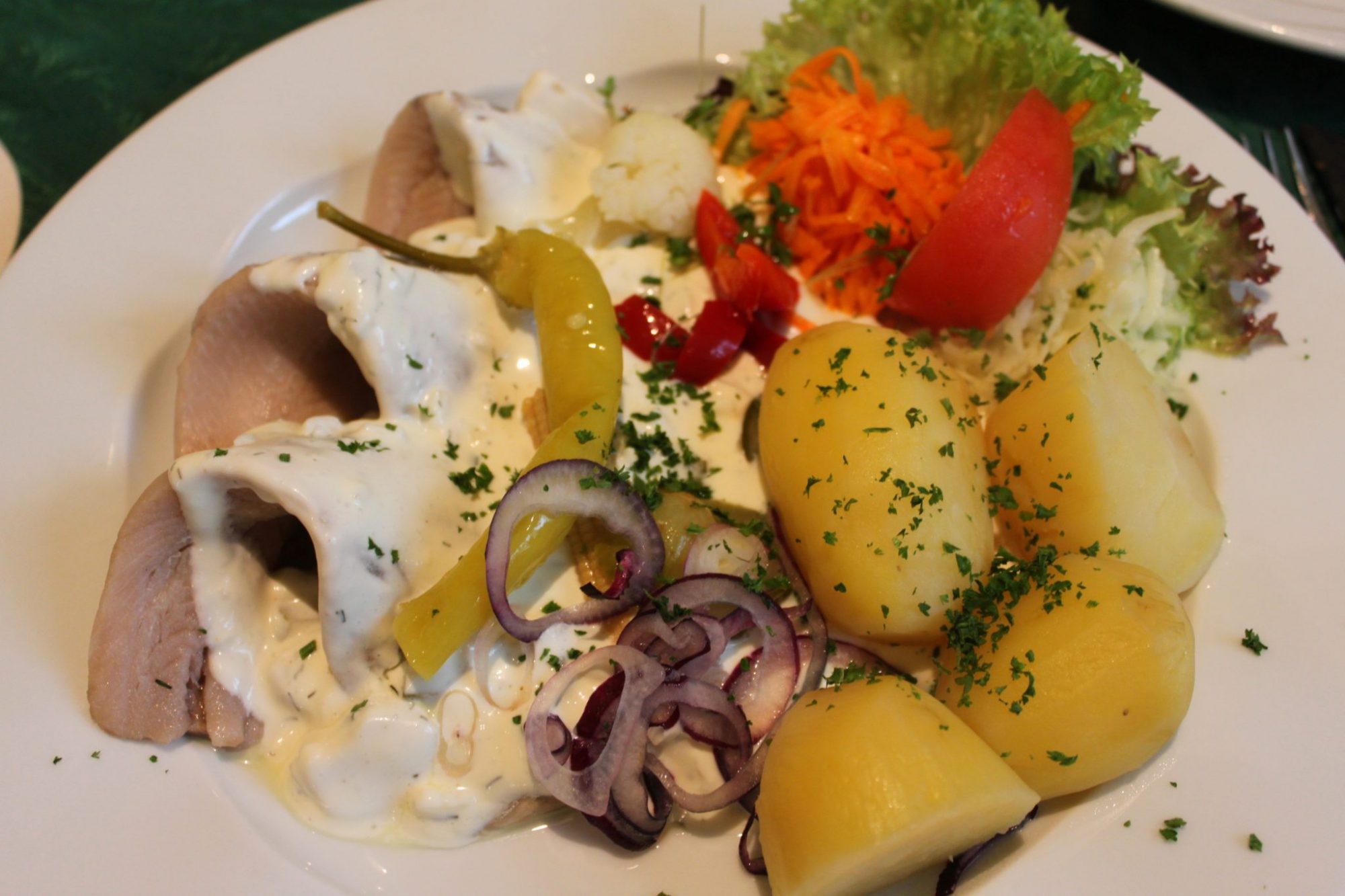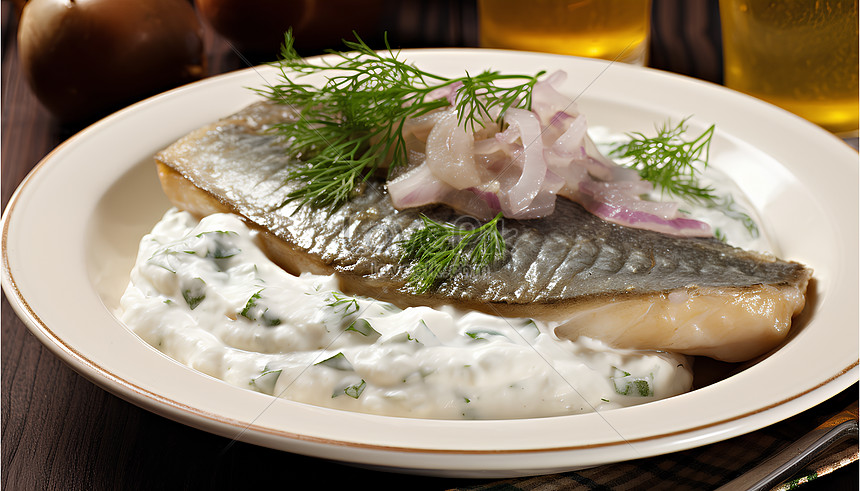Matjes herring, a delicacy originating from Northern Europe, holds a special place in the culinary traditions of the region. Loved for its tender texture, mild flavor, and rich cultural heritage, Matjes herring is a beloved dish enjoyed by locals and revered by food enthusiasts around the world. In this article, we’ll delve into the history, preparation, and culinary significance of Matjes herring.

Matjes herring
Contents
History and Origins:
Matjes herring has a long and storied history dating back centuries in Northern Europe, particularly in countries such as the Netherlands, Germany, Denmark, and Sweden. The term “Matjes” is derived from the Dutch word “maatjes,” meaning “mates” or “young herring,” referring to the immature herring caught during the early summer months when they are at their peak flavor and texture.
Preparation Process:
The preparation of Matjes herring is a meticulous process that involves curing freshly caught herring in a brine solution made from water, salt, and sugar. The herring is gutted and beheaded, leaving the pancreas intact, which aids in the fermentation process. After curing for a few days, the herring is filleted and traditionally served with accompaniments such as onions, pickles, and sour cream.
Flavor Profile and Texture:
Matjes herring is prized for its delicate flavor and tender texture, which distinguishes it from other varieties of herring. The young herring has a mild, buttery taste with a hint of sweetness, complemented by the tangy brine and subtle notes of herbs and spices. The flesh is soft and silky, melting in the mouth with each bite, making it a true delicacy for seafood enthusiasts.
Health Benefits:
In addition to its culinary appeal, Matjes herring offers numerous health benefits as a rich source of omega-3 fatty acids, vitamins, and minerals. Omega-3 fatty acids are essential for heart health, brain function, and reducing inflammation in the body. Herring is also high in protein, making it a nutritious and satisfying addition to a balanced diet.
Global Appeal:
While Matjes herring has its roots in Northern Europe, its popularity has spread to other parts of the world, where it is enjoyed by seafood aficionados and adventurous eaters alike. Gourmet food markets, specialty stores, and upscale restaurants often feature Matjes hering on their menus, showcasing the timeless appeal and culinary versatility of this beloved delicacy.
Matjes herring is more than just a seafood dish; it’s a culinary treasure steeped in history, tradition, and regional pride. Loved for its delicate flavor, tender texture, and health benefits, Matjes herring continues to captivate the palates of food enthusiasts around the world, reaffirming its status as a timeless delicacy of Northern Europe. Whether enjoyed as a simple snack or an elegant appetizer, Matjes herring is sure to delight the senses and leave a lasting impression on anyone fortunate enough to taste its exquisite flavor.
Pros and Cons of Matjes Herring Flavor: Exploring the Taste
Matjes herring, a delicacy revered in Northern European cuisine, boasts a unique flavor profile that delights seafood enthusiasts and challenges the palates of the uninitiated. From its delicate sweetness to its subtle tanginess, Matjes hering offers a culinary experience unlike any other. In this article, we’ll explore the pros and cons of Matjes hering flavor, highlighting its distinctive characteristics and potential drawbacks.

Matjes herring
Pros of Matjes Herring Flavor:
- Delicate Sweetness: One of the most appealing aspects of Matjes herring is its delicate sweetness, which sets it apart from other varieties of herring. The young herring, cured in a brine solution, develops a natural sweetness that balances the salty and tangy notes, creating a harmonious flavor profile.
- Tender Texture: Matjes herring is prized for its tender texture, with flesh that is soft and silky, almost melting in the mouth with each bite. The gentle curing process preserves the natural texture of the hering, resulting in a luxurious mouthfeel that enhances the overall eating experience.
- Balanced Flavor: Another advantage of Matjes herring flavor is its balance of savory, salty, and tangy elements. The brine solution infuses the herring with subtle hints of herbs and spices, adding depth and complexity to the flavor without overpowering the delicate taste of the fish.
- Nutritional Benefits: In addition to its delicious taste, Matjes herring offers numerous health benefits as a rich source of omega-3 fatty acids, protein, and essential nutrients. Omega-3 fatty acids are known for their heart-healthy properties, while hering is also high in vitamin D, vitamin B12, and selenium.
Cons of Matjes Herring Flavor:
- Strong Fish Taste: While some appreciate the distinctiveness of herring flavor, others may find it too intense or “fishy” for their liking. Matjes hering has a pronounced fish taste that may be off-putting to individuals who are not accustomed to eating seafood or who prefer milder flavors.
- Salty Brine: The brine solution used to cure Matjes hering can sometimes impart a salty taste to the fish, especially if it is not properly balanced with sugar and other seasonings. Excessive saltiness can overwhelm the palate and detract from the overall enjoyment of the dish.
- Acquired Taste: Due to its unique flavor profile, Matjes hering may be an acquired taste for some people, particularly those who are not familiar with Northern European cuisine or who have not grown up eating herring. It may take time for individuals to appreciate the nuances of Matjes herring flavor fully.
- Potential Allergens: Individuals with seafood allergies or sensitivities should exercise caution when consuming Matjes herring, as it may contain allergens such as fish proteins and shellfish contaminants. Cross-contamination in processing facilities could also pose a risk for those with severe allergies.
Matjes herring flavor offers a balance of sweetness, mariatogel saltiness, and tanginess that appeals to seafood connoisseurs and adventurous eaters alike. While its distinctive taste may not be to everyone’s liking, Matjes herring’s tender texture, nutritional benefits, and cultural significance make it a beloved delicacy in Northern European cuisine. By weighing the pros and cons of Matjes herring flavor, individuals can make informed decisions about whether to indulge in this iconic seafood dish and savor its unique taste experience.
Matjes Herring Review: Exploring the Delicacy of Northern European Cuisine
Matjes herring, a traditional delicacy of Northern European cuisine, has garnered attention for its unique flavor, tender texture, and rich cultural heritage. Loved by locals and celebrated by food enthusiasts worldwide, Matjes herring offers a culinary experience that is both intriguing and satisfying. In this review, we’ll delve into the characteristics, taste, and overall impression of Matjes herring, providing insight into why it holds a special place in the hearts and palates of so many.

Matjes herring
Appearance and Presentation:
Matjes herring is typically presented as fillets of young, tender hering, delicately cured and preserved in a brine solution. The fillets often have a pale pink or ivory color, with a glossy sheen that hints at their freshness and quality. When served, Matjes herring may be accompanied by traditional garnishes such as onions, pickles, capers, and sour cream, enhancing its visual appeal and flavor profile.
Texture and Mouthfeel:
One of the most remarkable aspects of hering is its tender texture, which sets it apart from other varieties of herring. The flesh is soft and succulent, with a delicate consistency that practically melts in the mouth with each bite. The smooth, buttery texture of Matjes hering adds to the overall enjoyment of the dish, creating a luxurious mouthfeel that leaves a lasting impression.
Flavor Profile:
Matjes herring boasts a nuanced flavor profile that is both delicate and complex. The young herring, cured in a brine solution, develops a subtle sweetness that balances the savory and salty notes, creating a harmonious taste experience. The tangy acidity of the brine adds a refreshing zing to the fish, while hints of herbs and spices contribute depth and complexity to the flavor. Overall, Matjes hering offers a well-rounded taste that appeals to a wide range of palates.
Health Benefits:
In addition to its delicious taste and cultural heritage, Matjes hering offers numerous health benefits as a nutrient-rich seafood. Herring is a rich source of omega-3 fatty acids, which are essential for heart health, brain function, and reducing inflammation in the body. It is also high in protein, vitamins, and minerals, making it a nutritious and satisfying choice for those seeking to maintain a balanced diet.
Conclusion:
In conclusion, Matjes herring is a culinary gem that delights the senses and nourishes the body, offering a taste of Northern European tradition and heritage. With its tender texture, nuanced flavor, and cultural significance, Matjes hering has earned its place as a beloved delicacy that continues to captivate the palates of food enthusiasts around the world. Whether enjoyed as a simple snack, an elegant appetizer, or a festive feast, Matjes hering is sure to leave a lasting impression and evoke fond memories of shared meals and cherished traditions.
Read More Article About “Diamond Ring: Dazzling Brilliance to Elevate Your Style“



